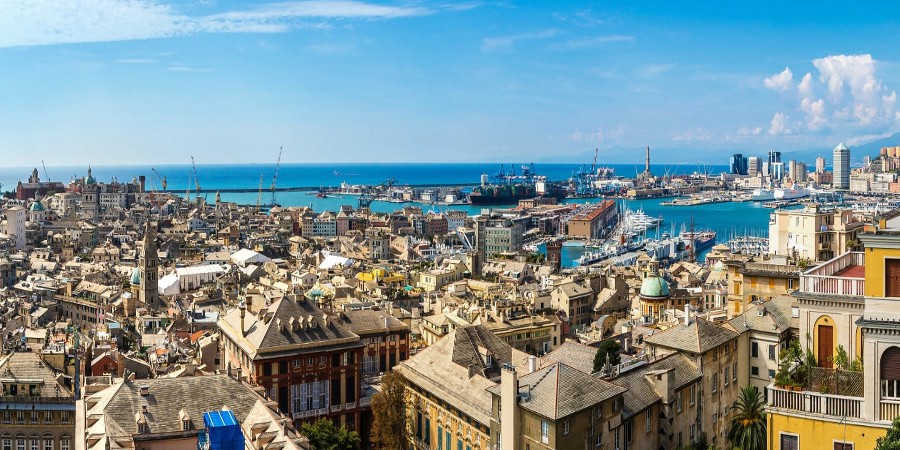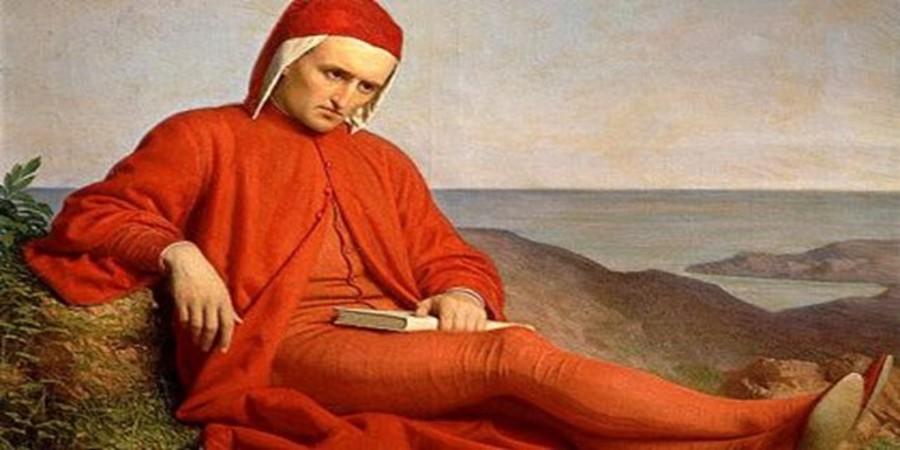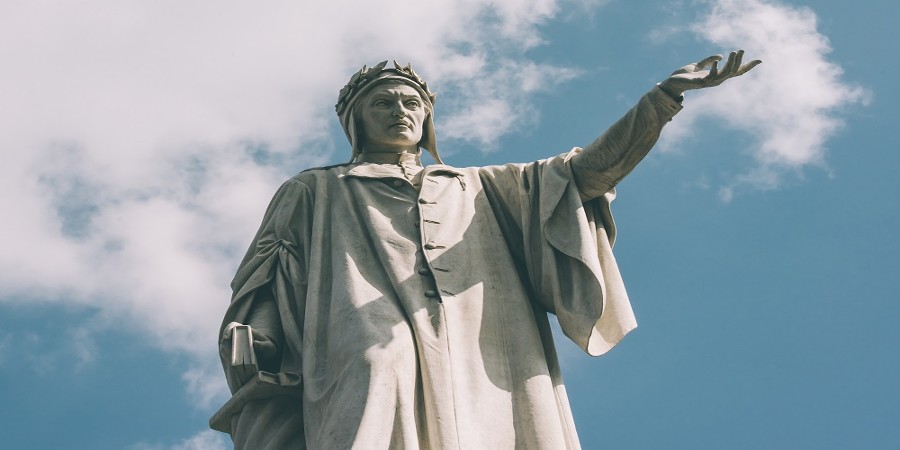IN LIGURIA, ON THE TRAIL OF DANTE ALIGHIERI - TRIP CODE: DANTETRAIL
5 days 4 nights
1st day: Sanremo
Arrival in Sanremo in the afternoon and hotel accommodation. Guided tour of the capital of the Riviera dei Fiori with the ancient part, called "Pigna", typical medieval look with the houses perched, the small squares and steep streets, and the modern Sanremo with its elegant buildings, and its parks that extend towards the sea. Return to the hotel, dinner and overnight.
2nd day: Triora and Albenga, on the tracks of Dante
The morning starts with breakfast at the hotel, then meeting with the guide and day dedicated to the discovery of Dante’s places in Triora and Albenga.
The itinerary begins with a visit of Triora, an ancient village known for its witchcraft processes, where we can find the Church of San Bernardino, beautiful place of worship dating back to the 15th century which has inside frescoes of the Last Judgement clearly inspired by Dante: The Paradise at the top is a real heavenly Jerusalem, further down the Limbo with the children dead before baptism and then a terrible Hell divided into seven parts as the seven deadly sins. The frescoes are believed to be the work of a Tuscan painter still unknown.
In addition to this little church where there are the strongest references to Dante we can still assert that the whole village of Triora, with its dark alleys, could appear in a circle of Purgatory if not Hell. In the historic center you can then visit the large parish church and the ethnographic museum with a section dedicated to witches.
Free lunch. In the afternoon transfer to Albenga for a visit to the Church of San Giorgio in Campochiesa, near Albenga, one of the hidden treasures of Liguria. Inside we find a fresco of the Last Judgement of 1446 where in the representation of the hellish bolgia, just in front of the famous Count Ugolino della Gherardesca that gnaws on the skull of Bishop Ruggeri degli Ubaldini, the same Dante and his guide, the poet Virgil, are depicted. This, connected to the date of the work, just over a century after Dante’s death, is a truly unique case. Then visit Albenga with the archaeological area and the Via Julia Augusta, taking the route to Mount Bignone (over 500 meters). The guided tour flanks the ruins of a necropolis of Roman origin, which convey a feeling of ghostly stillness in stark contrast with the enchanting island of Gallinara, in the background, jewel set in the sea. The guided tour continues to the Sanctuary of the Madonna della Guardia, an ancient Marian shrine whose construction began in the seventeenth century, still a pilgrimage destination. In the evening return to the hotel, dinner and overnight.
3rd day: Noli and Genoa
Breakfast at the hotel and accommodation of luggage. Transfer to Noli, once thriving maritime republic.
Dante probably arrived there in 1306, as an exile, on his way to France.
Noli is quoted by Dante in the IV canto of Purgatory vv.25-27: "Vassi in Sanleo e discendesi in Noli/montasi su Bismantova e 'n Cacume/con esso i piè; ma qui convien ch’om voli"
The reference is to a particularly difficult descent, such as the steep slopes of Capo Noli coming from the west, compared to the ascent to the Fortress of Sanleo, the Stone of Bismantova or the top of Caccume.
Guided tour of one of the maritime republics, which in the 12th century enjoyed a great wealth thanks to the continuous trade by sea with other countries. Noli is a beautiful town that rises by the sea. From here, in fact, you can admire the fishing boats on the coast and you can enjoy the clean beach and the clear sea of the Ligurian Riviera. Free lunch.
In the afternoon transfer to Genoa. Of the well-known aversion of Dante for the Genoese, explained in the XXXIII canto of the Comedy with the verses: “Ahi Genovesi, uomini diversi/D'ogni costume e pien d'ogni magagna/Perché non siete voi del mondo spersi?” A lot of speculation has been made.
It probably derives from a dispute born in Genoa during his stay in Dante’s Superba, between 1311 and 1312. The poet after having an animated discussion with Branca Doria, would be attacked by some servants of the Doria. When he arrives in the 9th and last circle of Hell, which houses the traitors of the guests, Dante meets Branca Doria member of an illustrious Genoese family who had his father-in-law killed inviting him to a banquet. When Dante wrote of Branca Doria he was still alive but his sin had been so serious that his soul was already burning in hell. The guided tour of the historic center of the city will focus on the traces of Dante. In the evening dinner and overnight.
4th day: Sestri Levante, Chiavari and the Fiumana Bella
Breakfast at the hotel and accommodation of luggage. Meeting with the guide and transfer to Val Fontanabuona.
The Valley appears in the Comedy in the XIX Canto of the Purgatory, when Pope Hadrian V speaks of the Fieschi family: "Intra Siestri e Chiaveri s'adima una fiumana bella, e del suo nome lo titol del mio sangue fa sua cima".
The ruins of the ancient village of "Siestri" are located in Neirone, from which the entire valley takes place.
There aren’t traces of a presence of Dante in those places but probably passed there directed to Milan in 1311, after a mission in Lunigiana on behalf of the Malaspina. Today, along the main road of Val Fontanabuona, in San Colombano Certenoli, in the hamlet of Scaruglia, a bridge commemorates the Supreme Poet since 1981: it is the Ponte Dante Alighieri.
Transfer to Chiavari and free lunch.
Dante ascends the mountain of Purgatory, meeting the souls who are paying their sins, waiting to ascend to Heaven. Among these illustrious souls, in addition to Manfredi of Sicily and Oderisi from Gubbio (just to name a few), meets that of Pope Hadrian V, locked in the frame of misery. Pope Adrian V, born Ottobono Fieschi, was the 186th pope of the Catholic Church in 1276.
Ottobono Fieschi belonged to the rich and ancient Genoese family of the Fieschi, counts of Lavagna: he was the son of Teodoro Fieschi and Simona Camilla and was the brother of Nicolò, Beatrice and Opizzo. According to the most accredited interpretation, the term Chiaveri corresponds to today’s Chiavari, that is, where the river Entella (the Fiumana Bella) flows. Guided tour of the beautiful old town of Chiavari. At the end transfer to the hotel in Sestri Levante, dinner and overnight.
5th day: Sarzana and Val di Magra
Breakfast at the hotel and luggage accommodation. Transfer to Sarzana.
In one of his many pilgrimages, Dante Alighieri arrived in Sarzana on 6 October 1306 called to sign the peace between the Malaspina and the Bishop Count of Luni, protected by the powerful Fieschi family. In Piazza della Calcandola, now Piazza Matteotti, Dante was appointed procurator of the Malaspina with a formal act, in front of the notary Giovanni di Parente di Stupio in the presence of the Marquis Franceschino di Mulazzo, signing peace for the long-standing controversy between the Malaspina of Spino Fiorito and the Bishop Conte di Luni.
Guided tour of the village and free lunch.
After the appointment to Sarzana on behalf of the Malaspina, the notary and Dante moved to Castelnuovo Magra to sign the peace act, in the presence of the Bishop Count of Luni who was based there. The Val di Magra is mentioned in canto XXIV of the Hell, verses 144-147: “Tragge Marte vapor di Val Di Magra/ ch’è di torbidi nuvoli involuto/e con tempesta impetuosa e agra” and in canto VIII canto of Purgatory when the soul of Corrado Malaspina asks him about the Val di Magra and the surrounding territories, verses 115-117: “Cominciò ella/di Val di Magra o di parte vicina/sai, dillo a me, che già grande là era…”. Guided tour of the testimonies present on the territory and departure.









